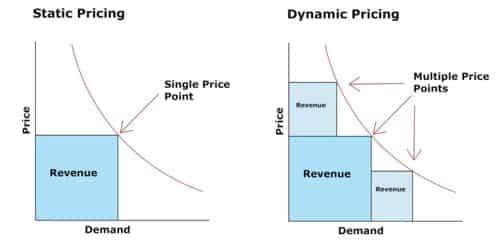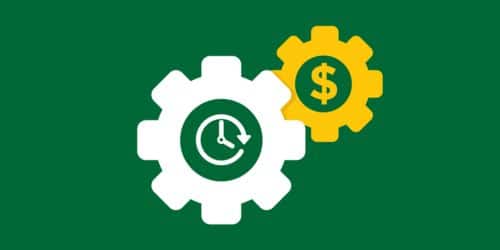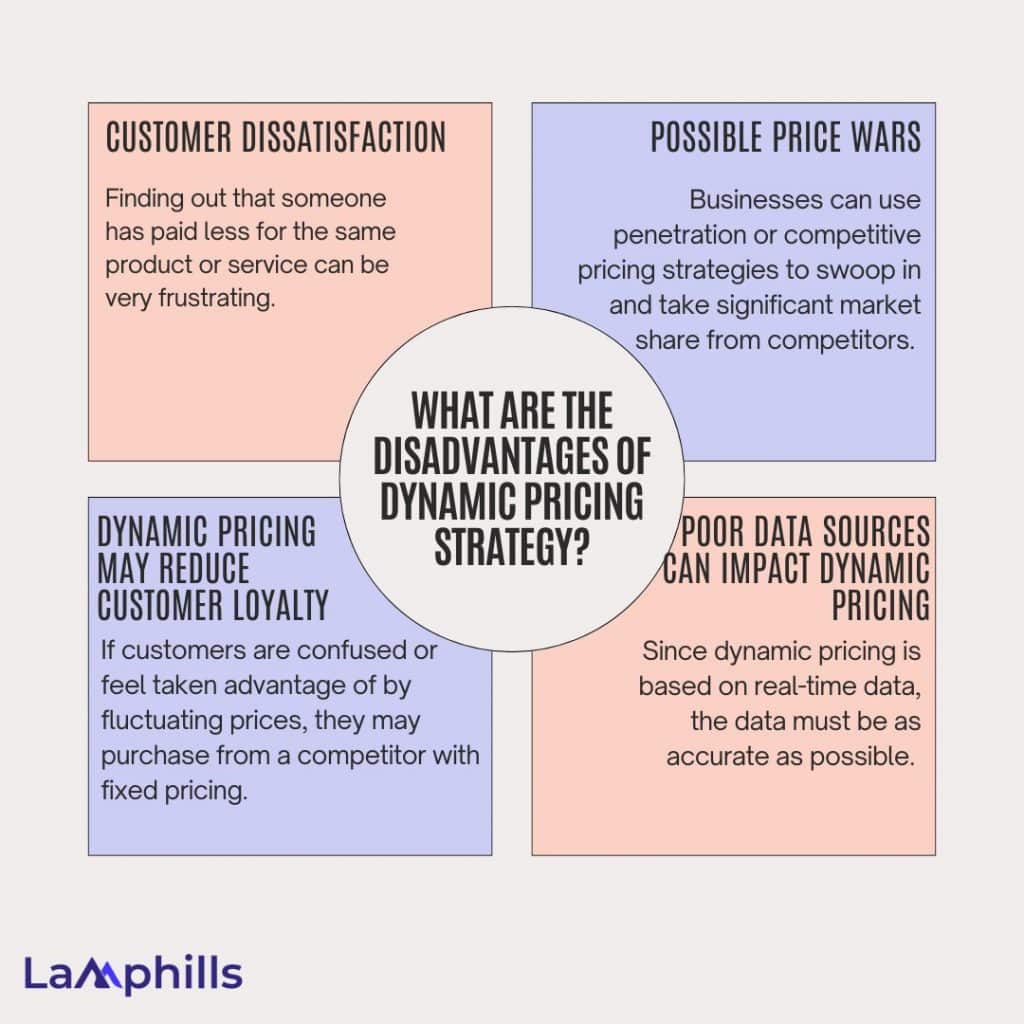Adjusting prices based on market demands is not new but more relevant than ever. Not that long ago, dynamic pricing was based on past sales data. Market demands were forecasted by analyzing seasonal and cyclical trends. Today, dynamic pricing involves more sophisticated procedures, such as large-scale data gathering and analysis.
Dynamic pricing has many equivalents, including surge pricing, demand pricing, intelligent pricing, and real-time or time-based pricing. In a broader sense, dynamic pricing strategy is part of pricing intelligence: a process where businesses gather and process data to adjust pricing strategies and grow profit.
Among numerous pricing strategies and methods, dynamic pricing stands out as a powerful weapon. This article will provide insight into dynamic pricing strategy examples, and some of its top benefits.
Read also: Pricing Strategies: Top 7 Examples of Pricing Strategies
Key Points
- Dynamic pricing is a strategy companies use to establish various market prices for products and services provided by different firms.
- Dynamic pricing strategy types include time-based, segmented, location-based, event-based, and peak pricing.
- Dynamic pricing strategy is generally legal and widely used across various industries, such as travel, hospitality, entertainment, and retail.
- Some potential pitfalls of this dynamic pricing strategy include customer dissatisfaction, possible price wars, dynamic pricing may reduce customer loyalty, and poor data sources that can impact dynamic pricing.
- Key components of a dynamic pricing strategy: data collection and analysis, pricing algorithms, segmentation, pricing flexibility, and clear objectives and KPIs.
What Is Dynamic Pricing Strategy?
Dynamic pricing is a strategy companies use to establish various market prices for products and services provided by different firms. Simply put, it’s a pricing strategy that utilizes variable prices instead of fixed ones. Simple huh? Retailers can adjust their prices to capitalize on a changing market. Technically, this is the same as “price discrimination,” a tactic declared illegal under the Robinson-Patman Act of 1936.

Fortunately, the Robinson-Patman Act has more holes than a wheel of Swiss cheese, making any legal basis for a price discrimination lawsuit rather ambiguous, particularly in the case of non-commodity goods sold online.
US courts and the Federal Trade Commission have repeatedly rejected dynamic price discrimination cases unless the discrimination was based on a category, such as gender, race, or sexual orientation, or was anti-competitive, which is highly unlikely to occur in an online market.
Thanks to the almost complete absence of legal action, businesses can use dynamic pricing strategies (sometimes called surge or demand pricing).
Dynamic Pricing Strategy Types
Join us below to explore the most common dynamic pricing strategies and provide real-world examples to illustrate their effectiveness.
By understanding these strategies and their applications, businesses can leverage dynamic pricing strategies to optimize revenue, improve customer satisfaction, and gain a competitive edge.
#1. Time-Based Pricing
Time-based pricing involves adjusting prices based on specific periods, such as peak hours, seasons, or weekdays versus weekends. This strategy allows businesses to capitalize on variations in demand and adjust prices accordingly.

For example, airlines often implement higher prices during peak travel seasons or on weekends when demand is typically higher. On the other hand, hotels may offer lower rates for midweek stays to attract more customers during slower periods.
#2. Segmented Pricing
This strategy involves setting different prices for identical products despite having the same production and distribution costs. This approach is evident in industries like manufacturing and distribution. For instance, a company may offer tiered pricing for its products, catering to different customer segments with varying needs and preferences.
Consider a manufacturing company that produces industrial equipment. They may offer different pricing tiers based on customer requirements, such as warranty coverage, additional services, or customization options. Customers who prioritize premium features and personalized solutions are willing to pay a higher price for the added value they receive.
By implementing segmented pricing, businesses can effectively cater to diverse customer segments, accommodating their unique preferences and willingness to pay. This strategy enables companies to maximize their revenue potential while delivering tailored solutions to market segments.
#3. Location-Based Pricing
Location-based pricing considers customers’ geographical locations and adjusts prices accordingly. This strategy considers regional preferences, economic factors, and purchasing power. For instance, movie theatres may offer lower ticket prices in less affluent neighborhoods to accommodate the local population’s purchasing power.

By adjusting prices based on location, companies can attract niche customers who highly value their product or service in that region.
For example, a distribution company specializing in delivering organic and vegan food products may charge slightly higher prices in affluent neighborhoods with more health-conscious consumers
#4. Event-Based Pricing
Event-based pricing involves adjusting prices based on specific events or occasions. This strategy takes advantage of the increased demand for concerts, sports games, or festivals. For example, ticket prices for a popular music concert may increase as the event date approaches, reflecting the higher demand from fans eager to secure their spot. Event-based pricing allows businesses to capture the maximum value of a limited-time opportunity.
#5. Peak Pricing
Peak pricing is closely related to event-based pricing and time-based pricing. As the name implies, peak pricing is closely tied to high-demand periods, whether at certain hours of the day or in specific seasons. It operates on the principle that prices can be higher during peak times when choices are limited and competition is scarce. A classic example of peak pricing is observed in the hotel industry, where room rates skyrocket during popular seasons compared to off-peak periods. This strategy capitalizes on the imbalance between supply and demand, allowing businesses to maximize their profits during periods of heightened customer interest.
A strategy driven by high demand, peak pricing is not limited to the hospitality industry. Even in the chemical industry, this pricing approach finds its application. For instance, consider a specialty chemical used in the production of paints. During the summer months, when construction activity and paint demand peak, suppliers may implement peak pricing to exploit the increased market demand. As a result, the price of specialty chemicals may rise during this period, aligning with the heightened demand and limited availability of alternatives. This enables chemical companies to optimize their revenue and capitalize on the seasonal fluctuations in the market.
Key Components of a Dynamic Pricing Strategy
Implementing a successful dynamic pricing strategy involves several critical elements that allow businesses to adjust their pricing models dynamically in response to market conditions and consumer behavior. Here’s a breakdown of the essential components that make up robust dynamic pricing models:
#1. Data Collection and Analysis
The foundation of any dynamic pricing strategy is data. Effective data collection and analysis enable businesses to make informed decisions based on real-time market insights and historical data trends. Key data points include:
- Competitor Pricing: Regularly monitor and analyze competitors’ pricing.
- Customer Data: Gather information on customer preferences, purchase history, and behavior patterns.
- Supply and Demand Metrics: Track inventory levels and demand fluctuations to adjust prices accordingly.
#2. Pricing Algorithms
Dynamic pricing relies heavily on sophisticated algorithms that can process vast amounts of data and adjust prices in real-time. These algorithms incorporate factors such as:
- The elasticity of Demand: Understanding how sensitive customers are to price changes.
- Seasonality and Trends: Adjusting prices based on seasonal demand and ongoing market trends.
- External Factors: Considering externalities like economic shifts, weather changes, or special events that can impact demand.
#3. Segmentation
Effective customer segmentation allows businesses to apply pricing strategies to different groups based on their behavior, demographics, or purchasing power. This helps maximize profits by targeting price changes to the segments most likely to respond positively.
#4. Pricing Flexibility
The ability to quickly adapt prices is crucial in dynamic pricing. This requires:
Real-time Pricing Capabilities: Implementing technology that instantly updates prices across all platforms.
Automated Systems: Using automated systems to apply pricing rules without manual intervention.
#5. Clear Objectives and KPIs
Defining clear objectives and key performance indicators (KPIs) is essential for measuring the effectiveness of a dynamic pricing strategy. Objectives might include increasing revenue, improving profit margins, or enhancing market share. Relevant KPIs could be sales growth, customer retention rates, or profitability.
Dynamic Pricing Strategy Examples: Use Cases
We will now explore some real-life examples of using a dynamic pricing strategy in eCommerce and point out important concepts to consider when implementing this pricing strategy.
#1. Dynamic Pricing in the Airline Industry
Airlines utilize complex algorithms and vast amounts of data to adjust prices dynamically, ensuring they maximize revenue for each flight. For instance, prices often start lower when tickets first go on sale and gradually increase as the flight date approaches and seats fill up. Conversely, airlines might lower prices or offer promotions to attract more passengers if a flight is not selling well.
This approach allows airlines to optimize their load factors (the percentage of available seats sold), ensuring they achieve the highest possible revenue per flight. It also enables airlines to remain competitive by quickly responding to changes in the market, such as new routes introduced by competitors or sudden shifts in travel demand due to economic or seasonal factors.
Dynamic pricing in the airline industry benefits airlines through increased profitability and efficient resource utilization. It also offers passengers a range of price points, encouraging early bookings and last-minute deals depending on their flexibility and travel needs.
Here, it is important to consider that price fluctuations can cause confusion and frustration as some customers often perceive price changes as unfair or exploitative. Transparency is key in these situations, and companies should always keep their customers informed on factors influencing pricing.
#2. Ride-Sharing Services: Uber
Customers pay the pricing that ride-sharing businesses like Uber set based on demand. Whether it’s a national holiday or a storm, the price of fares and the amount of time passengers must wait varies based on dynamic pricing decisions.
Dynamic pricing strategy is a good idea for ride-sharing companies because it can boost the supply of drivers in a specific region by strategically raising their pay. Another good reason is to lessen demand for rides and wait times. Customers unwilling to pay higher prices during peak hours will either look for another option or wait for pricing to return to normal.
#3. Airbnb
One of the peek examples of pricing strategies in hospitality industries is how AirBnB uses dynamic pricing strategy on its platform. Although AirBnB acts as a mediator – a rental platform connecting properties with renters – it also has a dynamic pricing function built into its platform. AirBnB calls this function “Smart Pricing,” and it automatically changes the prices of your property if certain factors are changed, such as season, demand, property features, or location.
Next, people can add constraints, such as a minimum price per night. These look like pre-defined business rules, which B2C and B2C companies frequently use in their pricing practices.
Property owners using Smart Pricing are 400% more likely to receive a booking than those without. AirBnB states that people who use the “Smart Pricing” function are 4x more likely to receive a booking than those who do not. They state that this function alone increases revenue for people by 12%. Amazon profits from this, too, by receiving more commissions.
Read also: STARTING AN AIRBNB BUSINESS: Steps in Starting an Airbnb Business
#4. MediaMarkt
Dynamic pricing strategy is not only implemented in online web shops, but it can also be implemented in brick-and-mortar stores. MediaMarkt, a European electronics company with more than 500 stores in different countries, implemented dynamic pricing with electronic price tags in stores.
According to their price manager, a TV can have different prices during different times of the day, but this also brings risks. Therefore, they decided to partially refund customers two weeks after their purchase if the product’s price was lower than when they bought it.
The key takeaway is that dynamic prices can harm the customer’s trust. People are more likely to accept frequent price changes for some products than others. They do not want to feel cheated. MediaMarkt specifically counters this dynamic pricing disadvantage by offering a partial refund.
#5. Ticketmaster
Pricing in entertainment events operates similarly to pricing in sports events. Is anyone ignorant about the Ticketmaster affair surrounding Taylor Swift’s Eras tour? We doubt it, but here is the excerpt.
It was found that Ticketmaster, the entertainment industry leader, controls about 70% of the ticketing and live events market, which indicates a non-competitive market. The company can not base its prices on competitors’ but mostly on demand. In the case of unexpected extreme demand for Swift’s concerts, the company was accused of boosting exclusivity and price discrimination due to enormous ticket prices. Now, the public is questioning whether a dynamic pricing strategy is ethical.
Dynamic pricing can not be either ethical or unethical. It is a business’s responsibility to implement all processes ethically and compliantly. Regarding prices, transparent communication is paramount, while confidential information is considered.
How to Implement a Dynamic Pricing Strategy?
Considering the available pricing data and factors like sales indicators, one can create a tool for checking prices at a particular frequency. In such a case, implementing a dynamic pricing strategy involves advanced analytics techniques fueled by Artificial Intelligence. These aspects can boost improvements in your pricing system.
What is more, dynamic pricing should be implemented by analyzing past data. Complex AI algorithms can look through massive volumes of data to recognize successful pricing patterns. Further, you set strategic goals and direct the insights from the dynamic pricing approach toward these objectives.

As you might have noticed, AI plays an important role in the process. To implement a dynamic pricing strategy, you need clear strategic objectives, sufficient data to gather and process, and insights that help align pricing approaches with broader business goals. Here are steps to successfully implement this strategy:
#1. Set a Business Goal
Start your dynamic pricing strategy by picking the commercial outcome your dynamic pricing model is trying to achieve. Here are some examples:
- Increased revenue
- Increased profit margins
- Higher market share
- Optimized inventory management
The business goal needs to be high-level enough to encompass various strategies and specific enough to understand the vision of your dynamic pricing.
#2. Outline Success and Guardrail Metrics
Without measuring the success of your dynamic pricing model, you will not know whether your strategy is on the right track.
You need to establish two sets of metrics: success metrics and guardrail metrics.
Success metrics help you directly measure the impact of your dynamic pricing model on the business outcome you chose in Step 1. Let’s look at a couple of examples of success metrics for different goals:

Alongside success metrics, you also need to establish guardrail metrics.
Guardrail metrics help you understand whether your dynamic pricing model has accidentally caused problems outside your revenue management.
Typical guardrail metrics are:
- Number of complaint and support tickets – especially when filtered by mentioning price
- Number of refunds and returns
- Customer churn rate
#3. Choose a Pricing Method
Once you know your business goal and how to measure it, it is time to set up your pricing method.
You need to decide whether to develop rule-based pricing or machine-learning algorithms that will guide price-point determination.
As a reminder, Rule-based approaches are usually easier to implement but reap fewer benefits. On the other hand, machine learning approaches are usually harder to implement but find more optimal price points.
#4. Collect Data
Dynamic pricing models only work when they’re based on quality data. Make sure to collect all the data you need.
For starters, you will need to collect data on your product costs and profit margins to understand the range in which your prices can fluctuate dynamically.
But you might also need other data. For example, if you opted for competitive pricing in step 1, you’ll need to collect data on how competitors price products.
Beware: data collection can be a black hole that consumes many engineering resources. Instead of collecting all your data yourself, rely on software solutions that automate it.
#5. Launch and Automate Price Point Determination
Once you have the data and have decided on the approach, push it into production.
You have three implementation options:
- Adjust prices manually based on goals and data.
- Code your dynamic pricing model yourself.
- Use dynamic pricing tools that automate the work for you.
- Pick option three if you want to get the best result out of your dynamic pricing strategy.
Unlike manual collection, it avoids human errors, and unlike home-brew solutions, you can test, deploy, and scale the model in weeks instead of wasting months of your engineering resources.
#6. Test and Monitor
Keep a finger on your dynamic pricing model performance.
Regularly check the success and guardrail metrics to see how the dynamic pricing model affects your business.
This step helps you evaluate whether your dynamic pricing strategy has been successful and whether you should continue or stop the model and revisit it.
#7. Rinse and Repeat
Dynamic pricing can always be improved. By using the success and guardrail metrics as baselines, you can set up more ambitious goals, tweak your rules/machine learning algorithm, and improve the performance of the dynamic pricing model.
What Are the Benefits of a Dynamic Pricing Strategy?
While dynamic pricing can be implemented across different realms and situations, it is crucial to understand the potential benefits it can bring. In such a context, the advantages of a dynamic pricing strategy are the following:
#1. Profit Maximization
With a dynamic pricing strategy, companies can track the value of particular products faster and more easily. Besides, one can track competitors’ prices and align pricing strategies accordingly. As a result, all these factors give a competitive advantage that can be translated into a higher profit margin.
#2. Understanding Consumer Behavior
Dynamic pricing helps companies understand core consumer behaviour points. Marketing experts can use dynamic pricing to understand which promotions impact customers most. Knowing how consumers behave makes marketing strategies more accurate and effective.
#3. Automatization of Benchmarks
Along with the ability to compare prices across competitors, a dynamic pricing approach can help companies keep up with the competition quickly. With benchmarking automatization, businesses can automate the process of dealing with competition.
#4. Control Over Pricing Approaches
Dynamic pricing grants a growing control over pricing approaches. The tool allows companies to access real-time pricing trends through thousands of products in a given industry. Dynamic pricing strategy can witness supply, demand, and price changes within a particular industry. The right degree of control helps set proper prices, bringing the most advantage to your company.
#5. Boosting Brand Value
Various eCommerce companies think dynamic pricing is an approach to avoid because it can hurt their brand image. The approach can help protect and boost brand image by helping companies set prices that reflect their brand value. What is more, changing prices accordingly can help them stay flexible and profitable at the same time.
What Are the Disadvantages of Dynamic Pricing Strategy?

Many feel dynamic pricing needs more transparency. These are some of the potential pitfalls of this dynamic pricing strategy.
#1. Customer Dissatisfaction
Finding out that someone has paid less for the same product or service can be very frustrating. Dynamic pricing can cause customers to feel they’re being taken advantage of. The Uber example above shows how public pressure can force companies to cap their prices in certain circumstances to make the practice more fair and transparent. Dynamic pricing must be carefully considered so as not to risk customer satisfaction.
#2. Possible Price Wars
Businesses can use penetration or competitive pricing strategies to swoop in and take significant market share from competitors. But what happens when competitors match or beat these prices? They have entered a price war, which can become a race to the bottom. Dynamic pricing can be useful in gaining a competitive edge, but companies must be cautious to remain profitable.
#3. Dynamic Pricing May Reduce Customer Loyalty
If customers are confused or feel taken advantage of by fluctuating prices, they may purchase from a competitor with fixed pricing. To minimize the possibility of diminished customer loyalty, ensure an excellent customer experience. Reduce friction on your e-commerce site to make purchasing easy, offer free or low shipping prices, and provide easy returns and exchanges with superior customer service.
#4. Poor Data Sources Can Impact Dynamic Pricing
Since dynamic pricing is based on real-time data, the data must be as accurate as possible. Otherwise, you’ll end up with a “garbage in, garbage out” situation that can wreak havoc on your profitability and sales volume. Ensure the data in your pricing system is as clean, current, and accurate as possible.
How Is Dynamic Pricing Legal?
Dynamic pricing strategy is generally legal and widely used across various industries, such as travel, hospitality, entertainment, and retail. However, its legality depends on how it’s implemented and adhering to specific laws and regulations regarding pricing practices. Here are several aspects that contribute to the legality of dynamic pricing:
#1. Compliance with Anti-Discrimination Laws
Dynamic pricing must comply with anti-discrimination laws. It should not set prices based on race, gender, ethnicity, nationality, or other protected classes. Ensuring pricing strategies do not inadvertently discriminate against any customer group is crucial for maintaining legality.
#2. Adherence to Consumer Protection Laws
Businesses must ensure that their dynamic pricing strategies do not violate consumer protection laws, which guard against deceptive or unfair practices. This includes providing clear information about pricing methodologies and ensuring price changes are not misleading or falsely advertised.
#3. Transparency
While not always a legal requirement, transparency about dynamic pricing can help businesses avoid consumer backlash and potential legal challenges. Transparency includes disclosing to customers that prices may change based on timing, demand, and other factors.
#4. Avoiding Price Gouging
Specific laws prevent price gouging during emergencies or disasters – excessively raising prices on essential goods or services. Businesses must be cautious with dynamic pricing in such scenarios to ensure compliance with local or state regulations.
#5. Fair Competition Laws
Dynamic pricing must also respect fair competition laws. This means that businesses cannot use dynamic pricing in a way that constitutes anti-competitive practices, such as predatory pricing aimed at driving competitors out of the market.
How to Beat Dynamic Pricing?
To create a comprehensive guide on how to counter or navigate dynamic pricing strategies effectively, here’s a detailed checklist I have provided covering various aspects businesses can consider:
How to Beat Dynamic Pricing Checklist
Is Dynamic Pricing Fair?
All business is based on supply and demand; dynamic pricing allows you to fine-tune your pricing to match these market forces. Although a customer who pays more for the same product or service may feel you are mistreating them, customers can always buy at a different time or from a different supplier. However, if you are the only provider of a critical product, like a vaccine, you should seriously reconsider using this strategy.
Bottom Line
In conclusion, you should be transparent about employing dynamic pricing on your site. However, this may not completely solve the cognitive dissonance of customers feeling like they are missing out or are simply not getting the best deal. All of the above suggestions aim to solve the problem of transparency and the feeling of missing out. Remember to be careful about your brand, image, and any PR backlash that could have a long-lasting impact. As long as you do it right, legal trouble is unlikely with dynamic pricing. Price transparency is key and should be at the forefront of decision-making. After all, you don’t want to create angry, inebriated customers who will yell and cuss at you on a Boston bus.
Similar Articles
- MARKETING STRATEGIES FOR ECOMMERCE BUSINESS
- Customer support: How, why and when to implement. (+bonus guide)
- 15 Best Inbound Marketing Tools That Can Save Your Business in 2024





